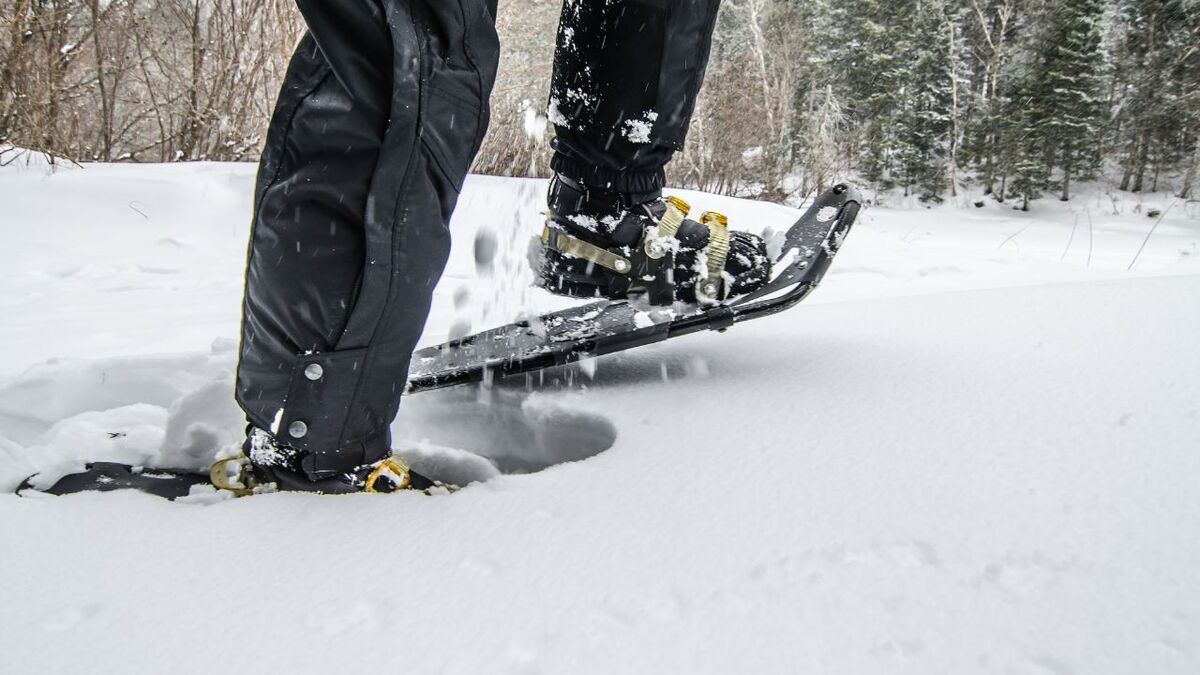
snowshoes
Noun
Meaning
Snowshoes are a crucial tool for winter survival and outdoor activities in snowy terrain. They are specially designed footwear that distribute your weight over a larger surface area, preventing you from sinking into deep snow. Snowshoes allow you to walk, hike, or even run on top of the snow, making it easier to navigate through winter landscapes. They provide stability, traction, and help conserve energy by reducing the effort required to move in deep snow. Snowshoes have been used for centuries by indigenous peoples and are still widely used today in activities such as winter camping, hiking, and backcountry exploration.

Examples
„I love using snowshoes to explore the winter wilderness. They make it so much easier to walk on deep snow without sinking in.“
„Last weekend, I went on a snowshoeing trip with my friends. We hiked up a snowy mountain and enjoyed the breathtaking views from the top.“
„When I go snowshoeing, I always make sure to wear warm and waterproof boots. It's important to stay dry and comfortable in the cold weather.“
„Snowshoes are not only practical, but they can also be a lot of fun. I often challenge my friends to races or try different techniques to improve my speed and agility.“
„If you're planning a winter camping trip, don't forget to pack your snowshoes. They will allow you to explore the snowy landscape and find the perfect spot to set up your camp.“
Origin
The word "snowshoes" originates from the combination of the words "snow" and "shoes". It has its roots in the indigenous cultures of North America, particularly the Native American tribes who inhabited snowy regions. These tribes developed the concept of snowshoes as a means of traversing deep snow without sinking.
Snowshoes have a long history and have been used for thousands of years. The design and materials used in snowshoes have evolved over time, but the basic concept remains the same. Traditional snowshoes were made from wood and rawhide, with a frame that resembled a tennis racket and a webbing that provided traction on the snow.
Today, snowshoes are made from a variety of materials, including aluminum, plastic, and synthetic fabrics. They come in different shapes and sizes, depending on the intended use and the type of snow conditions. Modern snowshoes are lightweight, durable, and designed to provide maximum flotation and traction on snow-covered terrain.
Snowshoeing has become a popular winter activity, enjoyed by outdoor enthusiasts and nature lovers around the world. It offers a unique way to explore snowy landscapes, allowing you to walk on top of the snow and access areas that would be otherwise difficult to reach.
Synonyms
Snowshoes, Snowshoeing, Snow boots, Winter shoes, Snow walkers, Snow hikers, Snow trampers, Snow trekkers
Antonyms
Skis, Ice skates, Rollerblades, Sandals, Flip-flops, Bare feet, Sneakers, Boots
Relatives
Winter, Snow, Hiking, Outdoor, Trekking, Snow boots, Winter sports, Snowshoeing
Historical and cultural importance
Snowshoes have a long history and cultural significance, especially in regions with snowy and icy conditions. They were originally developed by indigenous peoples in North America, such as the Inuit, Cree, and Ojibwe, who relied on them for winter travel and hunting.
These traditional snowshoes were made from wood frames and rawhide lacing, designed to distribute the weight of the wearer over a larger surface area, preventing them from sinking into the deep snow. They allowed for easier movement and navigation in snowy terrain, making it possible to travel long distances and access remote areas.
Over time, snowshoes have evolved and adapted to different cultures and environments. In Europe, snowshoes were used by trappers, hunters, and explorers in the mountainous regions. In Asia, snowshoes were used by the indigenous peoples of Siberia and the Himalayas.
Today, snowshoes are not only used for practical purposes but also for recreational activities such as snowshoeing and winter hiking. They have become popular among outdoor enthusiasts who enjoy exploring snowy landscapes and immersing themselves in nature during the winter months.
The cultural significance of snowshoes can still be seen in various traditional events and festivals, where snowshoe races and demonstrations are held to celebrate the history and heritage of winter travel. These events showcase the skills and techniques associated with using snowshoes, keeping the cultural traditions alive.
More information about the term snowshoes
Snowshoes: Exploring the Winter Wilderness
When winter arrives and blankets the landscape in a thick layer of snow, it can be a magical time to explore the wilderness. However, traversing through deep snow can be a challenging task. This is where snowshoes come in handy. These specialized footwear have been used for centuries by indigenous peoples and outdoor enthusiasts to navigate snowy terrain with ease.
The History of Snowshoes
The origins of snowshoes can be traced back thousands of years to indigenous cultures living in snowy regions. These early snowshoes were made from natural materials such as wood and animal hide. The design of snowshoes has evolved over time, with modern versions incorporating lightweight materials like aluminum and synthetic fabrics.
Native American tribes, such as the Inuit and the Cree, were among the first to develop and use snowshoes. They recognized the need for a larger surface area to distribute their weight and prevent sinking into the snow. The traditional snowshoe design features a frame with a webbing or lacing pattern, which helps to distribute the weight and provide traction.
Benefits of Snowshoes
Snowshoes offer several advantages when venturing into snowy landscapes. Firstly, they provide flotation by distributing your weight over a larger surface area, preventing you from sinking into the snow. This makes it easier to walk or hike through deep snow, saving you energy and reducing fatigue.
Secondly, snowshoes provide traction on slippery surfaces. The crampons or cleats on the bottom of the snowshoes grip the snow and ice, allowing you to maintain stability and prevent slips and falls. This is especially important when traversing steep slopes or icy terrain.
Furthermore, snowshoes allow you to access remote areas that would otherwise be inaccessible during the winter months. Whether you're exploring a winter wonderland, going on a backcountry adventure, or even hunting in snowy conditions, snowshoes enable you to move efficiently and safely through the snow-covered landscape.
Choosing the Right Snowshoes
When selecting snowshoes, there are a few factors to consider. The first is your weight, as different snowshoes are designed to support different weight ranges. Additionally, the type of terrain you'll be traversing should be taken into account. Snowshoes with larger crampons are better suited for icy or steep terrain, while smaller crampons are more suitable for packed snow or groomed trails.
It's also important to consider the length and width of the snowshoes. Longer snowshoes provide more flotation and are ideal for deep snow, while shorter snowshoes offer better maneuverability and are suitable for more moderate conditions.
Conclusion
Snowshoes are an essential tool for winter exploration and outdoor activities in snowy landscapes. They provide flotation, traction, and access to otherwise inaccessible areas. By choosing the right snowshoes for your weight and terrain, you can confidently venture into the winter wilderness and experience the beauty and serenity of nature in its frozen form.
Back to overview

